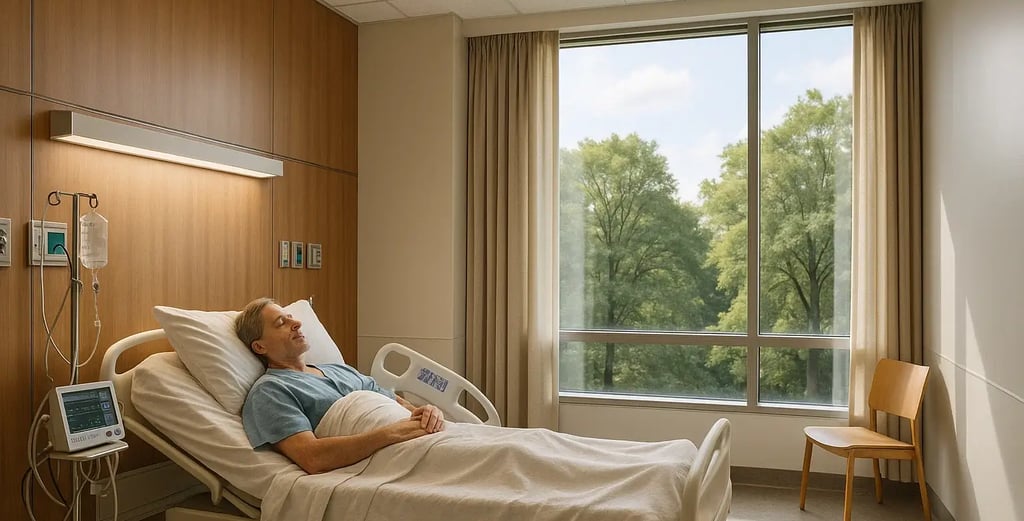Healing by Design: How Architecture Influences Patient Recovery
Discover how hospital architecture can directly influence patient recovery. Learn how thoughtful design elements like light, air, acoustics, and circulation improve health outcomes.
6/27/20252 min read
More Than Just Buildings
Modern healthcare architecture is about more than structural integrity — it’s about creating an environment that aids healing, reduces stress, and accelerates recovery. At Archora, we understand that design is not just functional; it’s emotional, sensory, and deeply human. Every hospital we design is rooted in a belief: the environment is a silent caregiver.
In this blog, we explore the science and strategy behind designing hospitals that don't just treat illness — they actively support recovery.
1. Natural Light & Nature Integration: The Power of Biophilic Design
Multiple studies have proven that exposure to natural light and views of greenery significantly improves patient outcomes:
Reduces anxiety and depression
Shortens hospital stays
Lowers the need for pain medication
Improves circadian rhythm and sleep quality
How Archora implements it:
South-facing windows in recovery wards
Internal courtyards and vertical green walls visible from patient rooms
Skylights in corridors and waiting lounges
2. Acoustic Optimization: Silence as Therapy
Noise pollution in hospitals — alarms, staff movement, machines — can elevate stress levels and interfere with healing. Acoustic comfort is often overlooked but is critical in environments like:
ICUs
NICUs
Post-operative wards
Design interventions we use:
Acoustic ceiling panels and sound-absorbing flooring
Zoned nurse stations with buffer corridors
Sealed HVAC ducting to reduce mechanical noise
Noise-masking technology in sensitive zones
3. Clean Air, Safe Spaces: Infection Control through HVAC Design
Hospital-acquired infections (HAIs) are a major concern. Air quality directly influences recovery rates and staff safety. That’s why our MEP (Mechanical, Electrical, Plumbing) engineering integrates infection-resistant airflow systems.
Our approach includes:
Zoned HVAC with HEPA filters in OTs and ICUs
Negative-pressure rooms for isolation
Fresh air intake in general wards to avoid recirculation
Separate air exhausts for sterile and non-sterile zones
Result: Enhanced patient recovery, lower infection risks, and NABH-compliant air safety.
4. Wayfinding & Circulation: Stress-Free Navigation
Wayfinding is not just signage. It’s about intuitive spatial design that makes movement effortless. Poor navigation causes stress, delays in emergency response, and confusion for patients and visitors.
Our design strategies:
Radial and spine-based circulation layouts
Departmental zoning: diagnostic, OPD, critical care, admin
Color-coded floors and corridors
Visual anchors like art, lighting features, and natural breaks
5. Human-Centric Interiors: Materials, Colors, and Finishes
Hospital interiors must support hygiene and healing. That’s a delicate balance.
Archora’s material palette includes:
Anti-microbial and non-slip flooring
Seamless, easy-to-clean wall coatings
Non-glare surfaces to reduce eye strain
Pastel and neutral tones to promote calmness
Color psychology examples:
Blue & green in ICUs = trust & serenity
Yellow in pediatric wards = warmth & cheer
Earthy tones in lobbies = grounded familiarity
6. Emotional Privacy & Psychological Safety
Healing requires dignity. Our architecture plans ensure visual and acoustic privacy, especially in semi-private wards and OPDs.
Features we design for privacy:
Recessed bed zones with curtains or partitions
Consultation rooms with sound insulation
Separate entrances for maternity or psychiatry wings
7. Future-Focused Design: Neuroarchitecture & Smart Hospitals
Architecture and neuroscience are intersecting rapidly. Design elements can now be tailored to affect brainwave activity, hormone production, and mood.
Neuroarchitectural cues we use:
Rhythmic spatial progression in hallways
Visual symmetry to reduce cognitive fatigue
Circadian lighting systems
Sensory integration through textures, lighting, and space modulation
We're also integrating smart technologies:
Occupancy sensors
Touchless wayfinding systems
Environmental control via patient app dashboards
Conclusion: Architecture as a Medical Tool
At Archora, every corridor, window, and wall is strategically designed to aid recovery. We collaborate with doctors, engineers, and administrators to ensure hospitals are not just medically efficient, but emotionally intelligent.
Design doesn’t just build hospitals. It builds hope, resilience, and healing.
Need a hospital designed for healing? Contact us at contact@archora.in or explore our Hospital Design Services.



ARCHORA
Where Infrastructure Inspires Healing
Innovate
Inspire
© 2025. All rights reserved.
Create
